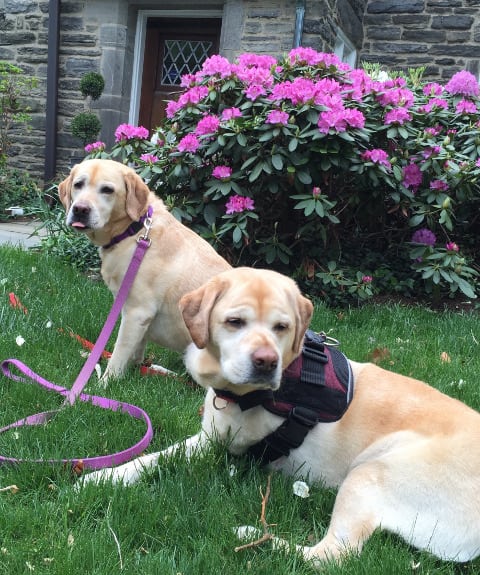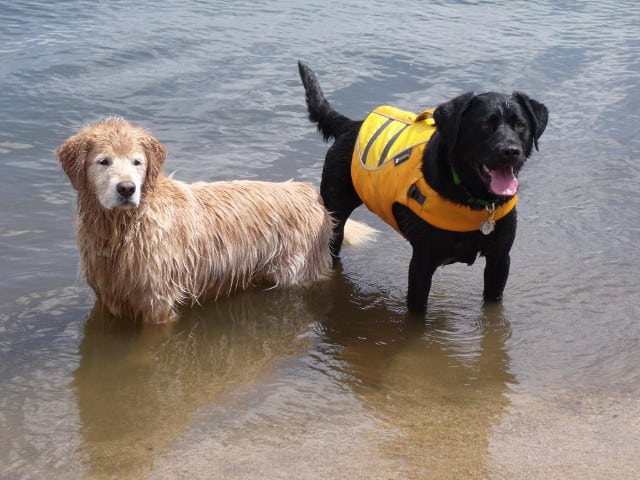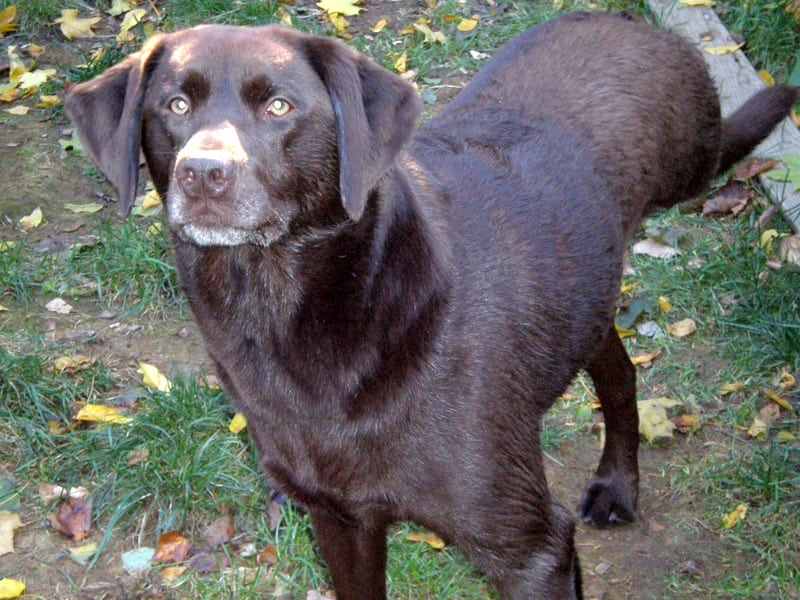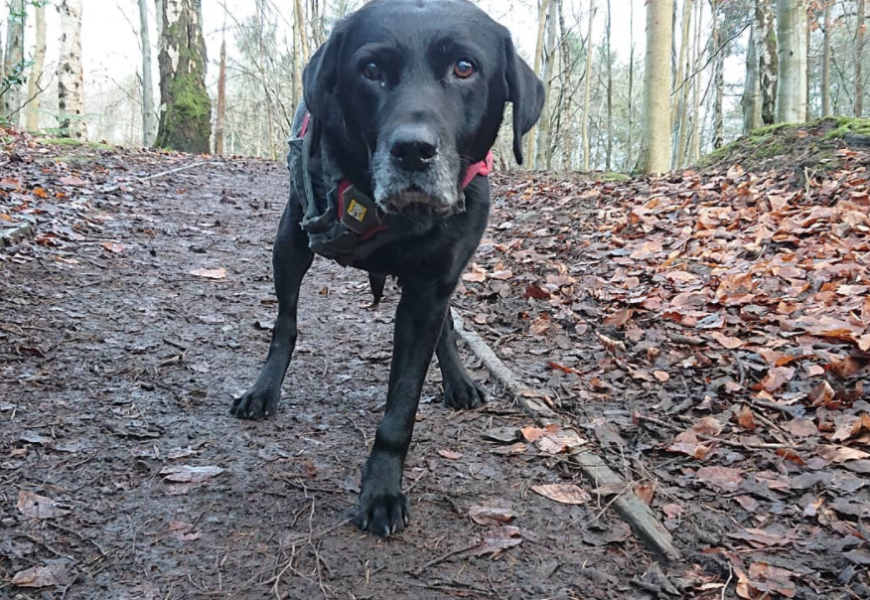Ten-year-old Wrigley excitedly bounded through the exam doors of Colorado State University Veterinary Teaching Hospital (CSU), pulling his white-coated vet behind him. His three legs didn’t slow him down a bit, even on the slippery tile floors, as he reunited with his four-legged sister Gracie and his mom after his 10-minute blood work appointment for his chemo check-up.
“Does he always run this fast?” asked the young vet.
“No, not always,” replied Wrigley’s mom. “He usually hops as at a fairly quick pace because it’s easier for him to go faster on three legs than it is to move slowly.”
“But,” she added, “He always runs to see his family after his check-ups and treatments.”
Six months before that appointment, Wrigley had been diagnosed with osteosarcoma and placed in a clinical trial at CSU that included $1,000 towards the amputation of his right front leg and covered his chemotherapy treatments. All dogs were placed in Group A or Group B – either receiving intravenous chemo only or intravenous chemo plus chemo pills to be administered at home. Wrigley was selected for the latter.
Prevalence of Osteosarcoma
Osteosarcoma is the most diagnosed primary bone tumor in dogs and children and is a biologically aggressive disease. In people, osteosarcoma is a relatively uncommon cancer, with 800–1,000 cases diagnosed per year. This is in contrast to dogs, where the annual incidence exceeds 25,000 cases.

Osteosarcoma is genetically similar in dogs and children, according to the results of a study published by Tufts University and the Translational Genomics Research Institute (TGen). Colorado State University contributed to this study, along with the Dana-Farber Cancer Institute, the Broad Institute, Ohio State University, and the University of Texas.
“While osteosarcoma is rare in children, it is all too common in many dog breeds, which makes it a prime candidate for the kind of comparative cancer biology studies that could enhance drug development for both children and our canine friends,” said Will Hendricks, Ph.D., an assistant professor in TGen’s Integrated Cancer Genomics Division, and one of the study’s senior authors.
A variety of giant and large breed dogs including Labrador retrievers, greyhounds, golden retrievers, German shepherds, Belgian malinois, and mixed breed dogs often suffer from osteosarcoma.
The study states that surgery and chemotherapy extend survival times, but approximately 30% of pediatric osteosarcoma patients die due to metastatic disease within five years and over 90% of canine osteosarcoma patients succumb to metastatic disease within two years following diagnosis.
The high rate of death makes identifying this disease earlier very important.
Diagnosis and the Search for Resources
When one of Wrigley’s front legs was showing signs of lameness, the first vet he saw diagnosed it as a muscle issue. After the limping and pain not only persisted, but seemed to get worse, his owners got a second opinion and heard the words that no person ever wants to hear about a family member …. “It’s cancer.”
Upon receiving this diagnosis, his owners weren’t sure what to do or where to turn. Like many pet owners, they’d never heard of amputating a pet’s leg. The vet referred them to CSU and during the initial consult there, they received collateral about amputation and the clinical trial, but in the days between the diagnosis and initial consult, and even after that appointment, they scoured the internet for more information.
Luckily, while researching osteosarcoma and amputation, they came across the Tripawds Foundation – a user-supported community for three-legged animals and their owners.
Wrigley’s owners read the research and blogs on the site to learn about dogs recovering from amputation, going through chemo, living on three legs, special dietary needs, and much more. While the educational resources provided a solid foundation, the emotional support the group offered was pivotal to caring for Wrigley both pre- and post-amputation.
How One Dog Made a Huge Difference
Back in 2006, Jim Nelson and Rene Agredano were faced with the same decision as Wrigley’s owners: Should they amputate their dog Jerry’s leg, and if so, what was the best way to care for him? What they found was a resource void – very little information and guidance on the topic.
“We didn’t even know dogs got cancer!” says Agredano. “The internet was filled with clinical and depressing statistics about his disease, and all we wanted was some hope that Jerry would be okay.”
Taking matters into their own hands, Nelson and Agredano started a little blog about their dog’s amputation recovery. Other pet parents with dogs facing the same disease soon found Jerry’s story while searching for support.”
Within weeks of Jerry’s limb loss, the couple started Tripawds.com, a free support community for guardians of amputee pets seeking guidance, veterinary information, and support for pets facing limb amputation.
In 2014, the couple founded the Tripawds Foundation, a 501c3 charity to support the Tripawds community and provide direct assistance programs to pet parents and their amputee animals.
“Pets bounce back from surgery pretty quickly,” says Nelson. “It’s their people who tend to need more help, emotionally speaking. And when they do want support, this community is here for them.”
International TriDay
The Tripawds Foundation has now taken the next step, announcing the inaugural TriDay on March 3.

TriDay is the official International Tripawd Awareness Day to raise awareness about limb amputation for our beloved pets. It is also a special day to recognize the incredible efforts of all pet parents, veterinarians, vet techs, oncologists, and rehab therapists who help Tripawds love life on three legs.
Born with three legs and a spare, amputation is sometimes the best way to improve quality of life for dogs and cats affected by limb cancers, congenital challenges, or injury.
“We couldn’t believe our Jerry would be happy on three, but right away he showed us that he could still have a great time in life with one less leg,” says Agredano. “Now, I try to help pet parents see the same future for their dog or cat. There’s nothing better than when their animal fully recovers, and they see it for themselves.”
Living Life on Three Legs to the Fullest
Wrigley, his parents, and his four-legged sister Gracie were determined to ensure that the rest of Wrigley’s life was lived with no regrets.
During Wrigley’s six months on three legs, he walked on his own, but his running came in the form of being pushed on the trails in a cart his family dubbed the “Wrigshaw,” with Gracie running alongside.
The pure joy he brought to others on the trail was unmatched. Other runners, cyclists, and walkers were more than a little surprised to see an 80-pound dog being pushed in a cart by a woman running, but it never failed to bring a smile to their faces. Children pointed him out to their parents, demanding mom or dad to “Look at the doggie in the stroller” and adults young and old broke into huge grins when they saw him. People exhibited joy seeing Wrigley so full of life.
Amy, Wrigley, and Gracie’s mission every single day became to show people to expect the unexpected … and to prove that, regardless of what obstacles life may throw at you, there’s always a way to enjoy what you love.

How the Tripawds Foundation Can Help
If your dog or cat is facing cancer and amputation, turn to the Tripawds Community and Tripawds Foundation for help.
The organization runs several direct assistance programs such as a toll-free support helpline, reimbursements for a Tripawd’s first rehabilitation therapy consultations, a pet cancer care package program, assistive gear donations, and an amputation surgery assistance program for financially distressed pet parents.
Most recently, the foundation kicked off the Tripawds Rescue Fund, which helps public shelters and nonprofit rescue organizations raise funds for adoptable animals needing a limb amputation. The Tripawds Foundation matches up to $500 in funds raised by organizations that meet the program requirements.
Donations made to the Tripawds Foundation website at Tripawds.org help maintain the Tripawds community and all of these incredible programs.
Celebrate on 3/3
Whether an animal is born with a limb difference, or undergoes amputation for any reason, March 3 is the best day of the year to showcase the resilient ways that dogs, cats, and other animals face limb loss and life on three legs.
To learn more about how to celebrate TriDay, visit https://triday.pet/.




